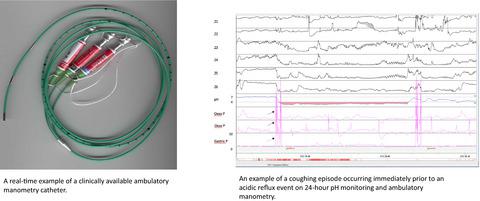当前位置:
X-MOL 学术
›
Neurogastroenterol. Motil.
›
论文详情
Our official English website, www.x-mol.net, welcomes your
feedback! (Note: you will need to create a separate account there.)
The role of ambulatory 24-hour esophageal manometry in clinical practice.
Neurogastroenterology & Motility ( IF 3.5 ) Pub Date : 2020-05-11 , DOI: 10.1111/nmo.13861 Afrin N Kamal 1 , John O Clarke 1 , Jac M Oors 2 , Albert J Bredenoord 2
Neurogastroenterology & Motility ( IF 3.5 ) Pub Date : 2020-05-11 , DOI: 10.1111/nmo.13861 Afrin N Kamal 1 , John O Clarke 1 , Jac M Oors 2 , Albert J Bredenoord 2
Affiliation

|
High‐resolution manometry revolutionized the assessment of esophageal motility disorders and upgraded the classification through the Chicago Classification. A known disadvantage of standard HRM, however, is the inability to record esophageal motility function for an extended time interval; therefore, it represents only a more snapshot view of esophageal motor function. In contrast, ambulatory esophageal manometry measures esophageal motility over a prolonged period and detects motor activity during the entire circadian cycle. Furthermore, ambulatory manometry has the ability to measure temporal correlations between symptoms and motor events. This article aimed to review the clinical implications of ambulatory esophageal manometry for various symptoms, covering literature on the manometry catheter, interpretation of findings, and relevance in clinical practice specific to the evaluation of non‐cardiac chest pain, chronic cough, and rumination syndrome.
中文翻译:

动态 24 小时食管测压在临床实践中的作用。
高分辨率测压彻底改变了食管动力障碍的评估,并通过芝加哥分类升级了分类。然而,标准 HRM 的一个已知缺点是无法在较长的时间间隔内记录食管运动功能。因此,它仅代表了食道运动功能的更快照视图。相比之下,动态食管测压法可长时间测量食管运动,并检测整个昼夜节律周期中的运动活动。此外,动态测压能够测量症状和运动事件之间的时间相关性。本文旨在回顾动态食管测压对各种症状的临床意义,涵盖有关测压导管的文献、结果的解释、
更新日期:2020-05-11
中文翻译:

动态 24 小时食管测压在临床实践中的作用。
高分辨率测压彻底改变了食管动力障碍的评估,并通过芝加哥分类升级了分类。然而,标准 HRM 的一个已知缺点是无法在较长的时间间隔内记录食管运动功能。因此,它仅代表了食道运动功能的更快照视图。相比之下,动态食管测压法可长时间测量食管运动,并检测整个昼夜节律周期中的运动活动。此外,动态测压能够测量症状和运动事件之间的时间相关性。本文旨在回顾动态食管测压对各种症状的临床意义,涵盖有关测压导管的文献、结果的解释、











































 京公网安备 11010802027423号
京公网安备 11010802027423号